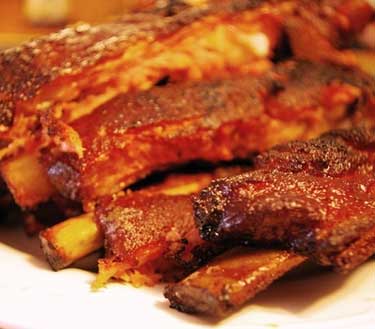 |
Not all barbecue joints are cut from the same piece of hickory. Barbecue is different wherever you go in the United States. But there’s one thing for certain: each barbecue cook, or pit boss, always believes that his or hers is the best. Yep. There’s a lot of ego in the world of barbecue. But usually the best barbecue joints, let’s say in the Hill Country of Texas or on Beale Street in Memphis, don’t have to tell you they are the best–just one taste of a properly slow-cooked, smoked pork butt or beef brisket speaks for itself. Here are a few things to know as you head out to eat some barbecue this spring.
1) It’s the Wood That Makes the Barbecue
Each barbecue cook has a favorite wood, and this often corresponds to the region. Aromatic mesquite wood is common in Texas. Hickory is popular in the South. Apple wood is the choice for barbecue places in the Northwest. (What? Seattle has barbecue?) There’s also cherry wood, oak, pecan, and alder–depending upon where you live. One constant remains, though, no matter what wood gets used: the meat of choice, which is most certainly a tougher cut, must be slow-cooked with hardwood for hours in order for it to be super-tender. (There is nothing worse than tough barbecue; it’s kind of like chewing on a wad of smoky rubber bands.)
2) Barrel Smokers, Pits, and Spits
Speaking of slow cooking, there are several methods for achieving barbecue bliss. Most barbecue joints use one of three cooking options: barrel smokers, pits, and spits. Barrel smokers, which use wood chips and other small pieces of hardwood, are great for controlling the lower temperatures needed for slow-cooking meat such as ribs, brisket, and pork shoulder. Pits are simply open fire pits that burn aromatic wood. The meat goes on top of the heat source, making for flavorful, tender barbecue–if the pit is burning at a low temperature. The pit technique requires much attention from the pit boss in order to keep an even temperature. The least popular method is spit cooking, where the meat is cooked on a rotisserie (or a rack) that is placed over an open fire.
3) You Say Missouri, I Say Missoura
The state of Missouri, which is often referred to as the Western edge of barbecue land, especially Kansas City, has its own style of barbecue. But, of course, the fare you get in
Kansas City is different than the stuff served in St. Louis. Kansas City-style barbecue, usually smoked with hickory, is known for it’s thick, tangy sauce, baby back pork ribs, chicken, and burnt ends, which are the end cuts of beef brisket tossed in sauce. The preferred sides in Kansas City are baked beans, cole slaw, and French fries. St. Louis-style barbecue is closer to the Tennessee version of barbecue, with pulled pork sandwiches being quite popular. Eastern Missourians also like the wider pork spare ribs and pork steaks–cooked over smoldering hickory. The chosen sides in St. Louis are potato salad and zesty cole slaw. The sauce is thinner than the Kansas City variety, with a good vinegar kick.
4) Everything Is Big In Texas
Head South to Texas for a different twist on barbecue. (It should be noted that some barbecue aficionados, who can be snobbier than sushi geeks, don’t consider the Texas variety to be true barbecue.) Mesquite wood is often used in the Lone Star State, but hickory also is common in some parts. Texans love their sliced brisket (served on thick slices of white bread), smoky sausage, and pork ribs. But let’s not forget that Texas is beef country, so big racks of beef ribs (think Fred Flintstone) are also popular. The tomato-based sauce is thick and often spicy, considering the Tex-Mex culture down there. Sides range from spicy pinto beans to spud salad to creamy cole slaw. Since Texas is such a large state, the styles of barbecue change from region to region.
